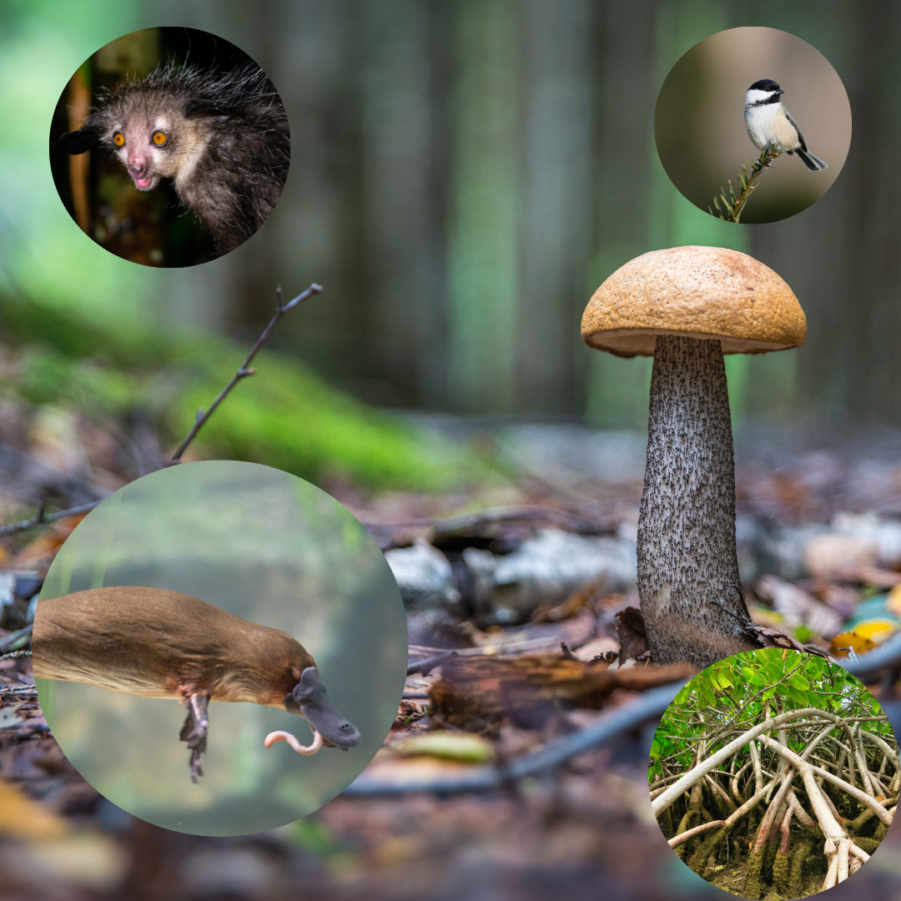I had so much fun tracking down scary nature facts for Halloween that I decided to continue that theme in future posts. Conveniently, several readers asked for weird nature facts to impress their friends or make an amusing topic in social settings. Luckily for us, nature always delivers. Especially in the weird department.
For this next edition of Biologist Ruins Everything, let’s delve into some of the strangest and most bizarre things I’ve learned about the natural world. I call them my top 15 weird nature facts!
1. Platypi can sweat milk
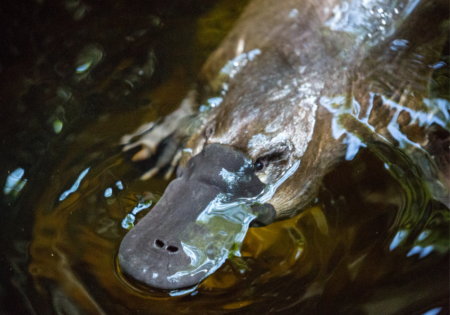
To be fair, very few things about platypi aren’t weird. These Australian mammals are part of a mostly-extinct group of mammals known as monotremes that have some un-mammalish habits. For example, laying eggs! However, like other good mammal mothers, platypi do care for their young.
Instead of feeding their babies through a well-developed teat or nipple like other mammals, platypi secrete milk more diffusely. In other words, they “sweat” out the milk from mammary glands. The result? Milk sort of oozes from a region of their skin, which the young platypi (sometimes called puggles) can lap up.
2. Many fish change sex as they age

About two percent of fish species can change their sex during their lifetimes. Some tropical fishes like many in the wrasse family (Labridae) actually change sex based on their age and size. This permanent change happens when they reach a certain age or size, usually because they can compete with other males for mating opportunities.
Think about it: A female fish living in a coral reef can spend years mating with nearby males to lay eggs and produce young. One day, she decides it’s time, and in a matter of weeks or months changes completely over to a male. Now, she is competing with her ex-boyfriends for opportunities to mate with local females. How’s that for a weird nature fact? Fish like these, including the wrasses and parrotfish (family Scaridae or subfamily Scarinae), which change from female to male, are known as protogynous.
3. Some animals can smell underwater
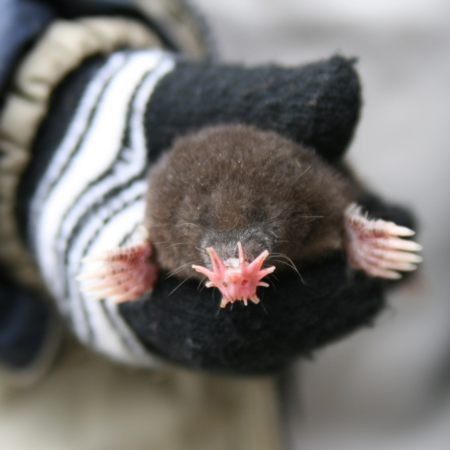
Lots of animals can sense, or “taste” chemical changes in water when they’re immersed. Have you ever accidentally swallowed some seawater while swimming on the coast? This is different, of course, than smelling the way a dog or a mouse would on land. However, some incredible mammals actually manage to use their acute sense of smell while hunting underwater. This allows them to make use of a land-based ability to sniff out prey, but apply it in an aquatic environment. That’s a lot easier than developing whole new senses to use while swimming!
Here’s how it works: when the animal is checking out an area underwater, it breathes out bubbles onto the surface it is sniffing. Then, it quickly breathes the bubbles back in, smelling chemical changes within them. If the bubbles have taken up the scent of a prey item, they can quickly identify it and snap it up. Typically their sense of touch comes next, allowing the animal to feel what it’s looking for and make an attack. For animals like the water shrew (Sorex palustris) and Russian desman (Desmana moschata), whiskers do the job. However, the North American star-nosed mole (Condylura cristata) has finger-like tentacles all over its nose that are far more effective!
4. There are mosses that only grow on moose poop
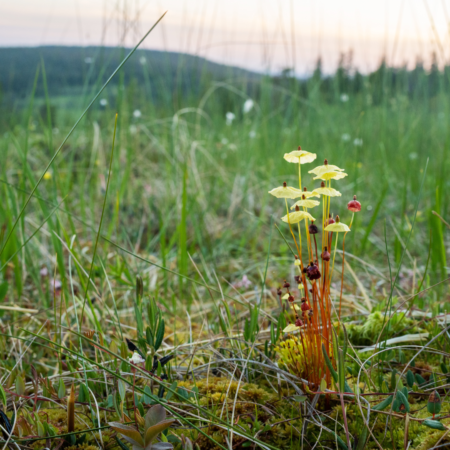
Mosses are fascinating and ancient plants with unusual lifestyles compared to the leafy plants with which folks are familiar. Being very small, tolerant of shade, and spreading via spores, they can end up in interesting places. In fact, mosses’ peculiarities often mean that they need to specialize in living in very particular places to compete for space. Here’s one for your weird nature facts: the red parasol moss Splachnum rubrum grows only on moose poop.
This pretty little moss, less attractively known as dung moss, makes its life on animal poo, particularly that belonging to American moose (Alces alces). But how do the mosses reach their poopy homes in the first place? Studies show that their fruiting bodies give off a smell that attracts flies, and these flies disperse moss spores to other dung sites.
Want to learn more about mosses? Check out this post!
5. Some plants and fungi pretend to be dead animals

If you read my post on mimicry, you may be aware that deception is a common game in nature. And animals aren’t the only ones that are doing the fooling! As it turns out, attracting insects is very important for many plants and fungi. Willingly or not, these insects might perform valuable functions like:
- Pollination, allowing plants to reproduce
- Dispersal, moving seeds or spores to new locations to maintain the population.
- In rare cases, providing food as in the case of carnivorous plants.
While we typically think of bees as as plant pollinators, there are a great many other species that get the job done. For example, butterflies and moths are common, as well as wasps. While those insect groups are attracted to bright colors and nectar rewards, many flies aren’t.
Weird plants
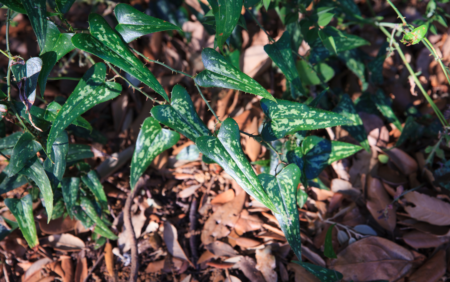
This brings us to the next of our weird nature facts. Rather than competing with other flowers for pollinators, some take advantage of unsuspecting flies that feed on dead animals. These flowers mimic the smell, color, and sometimes even textures of dead animals to attract carrion flies. The duped flies, beetles, and other corpse-eating insects will then bring their pollen from one flower to another. Some examples of carrion-imitating flowers include:
- Greenbriers or catclaw vines (Smilax) in North America
- Corpse flowers (genus Rafflesia) in the rainforests of Indonesia
- The Titan arum Amorphophallus titanum and its relatives
- Cactus like plants in the genus Stapelia, found in Southern Africa
- Some orchids in the genus Bulbophyllum, which includes flowers that smell like urine, poop, and other delightful perfumes!
Stinky fungi
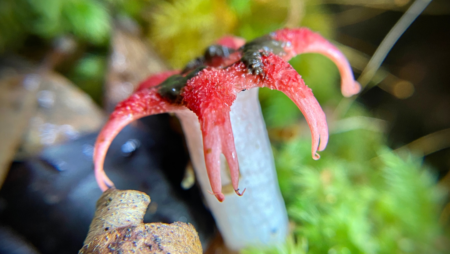
Fungi, which need to disperse their spores to other locations so that their young can find new habitats, employ a similar strategy. Many fungi take advantage of flies and other insects that feed or lay eggs on dung or dead animals. Similarly to flowers, but perhaps with more dramatic effects, they do this by mimicking those baits. These fungi take on ghoulish shapes, colors and textures, as well as awful smells, to tempt flies nearby.
Two common examples include stinkhorn mushrooms (genus Phallus) and cage fungi (Clathrus ruber). I was surprised (and a little grossed out) to find my first cage fungus in Queensland, Australia in 2023.
6. There is a species of snake with tentacles on its face

I’m going to be honest, I just didn’t see this one coming. While many of these weird nature facts were already floating around in the back of my head, this one caught me by surprise. There is a rare, aquatic snake in Southeast Asia that actually has tentacles on its face. Kind of like a star-nosed mole, it can use these weird, sensitive appendages to find its prey. What does the tentacled snake (Erpeton tentaculatum) eat for dinner? Fish!
The snake’s bizarre mustache of tentacles helps it feel small movements in the water that reveal the movement and location of prey fish. This, along with some very clever attacking movements, helps them catch fish with incredible accuracy.
7. Some birds change the size of their brain every winter

You read that right! Winter can be a very challenging time for animals. One of the biggest obstacles for birds is often having enough food to get through lean times. For birds in the tit family (Paridae), this means storing food in hidden places to access it later. This behavior, which scientists call caching, allows them to stockpile food for when they need it later on.
However, there is a major issue with caching food: the birds need to remember where they left it! During those colder, leaner times, food-storing birds need to have a really powerful memory. The rest of the year, not so much. Remarkably, scientists have found that birds that cache food actually experience an expansion of the part of their brain associated with memory during Winter. The hippocampus, which is associated with spatial memory, can grow as much as 30% in birds like the Black-capped chickadee (Poecile atricapillus).
Read more about common backyard birds
Once warm weather and abundant food are back in the Spring and Summer, there’s no need for a genius memory. Thus, the hippocampus of caching birds returns to its original size. Want to learn more about how different types of animals face the challenges of Winter? Check out this post!
8. Male anglerfish are sexy parasites
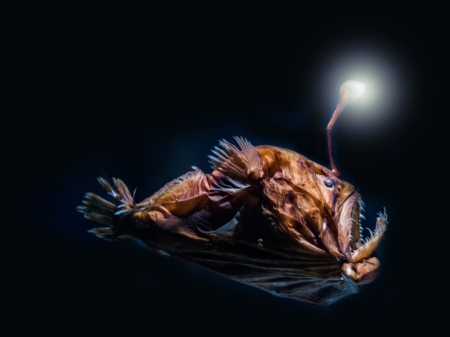
For many animals that lay eggs, females are typically larger than males because they need to produce the eggs. These eggs are energetically costly and also take up room, so females need to be larger. Meanwhile males, who contribute less expensive reproductive cells or gametes, can afford to be smaller. In some species of fish, however, the strategy of big females and little males takes a step further. Females in the deep sea anglerfish (family Ceratiidae) can be tens to hundreds of times larger than males.
But things get a heck of a lot weirder. Living in the deep sea can be lonely, and it’s hard for individual fish to find mates. When they do find one another, it makes sense for them to hold on rather than risk not finding another mate later. Instead, they become literally attached. No commitment issues here! Males in this family are actually parasitic; they plug into the female’s body and get nutrition out of it. At the same time, they provide the necessary sperm for mating and reproduction.
As if that weren’t bizarre enough, in some species the male actually slowly gets absorbed into the female’s body. Apparently lacking the immune cells that would keep this from happening, their tissues combine like two candles melting together. The male’s reproductive organs become essentially part of her body, allowing her to continue fertilizing her eggs. Males in this family are often so tiny and helpless they can’t feed themselves, and may not even have a complete digestive system. Instead, they have big eyes to find females and latch on.
9. There are ironclad “lava-snails” in the Indian ocean
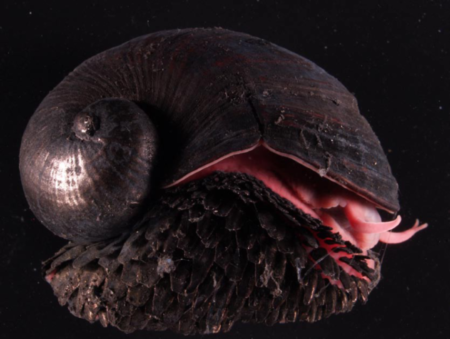
The scaly-foot snail (Chrysomallon squamiferum)’s weird adaptations definitely give it a place among my top weird nature facts. This bizarre marine animal lives around hydrothermal vents, boiling-hot seams in the Earth’s crust on the ocean floor. These vents are dark and hostile habitats, typically between 7900 and 9500 feet (2400-28000m) under the ocean. Magma (lava that is below the Earth’s surface) heats seawater that percolates down into the vents, and as it heats it comes spewing back out again. Temperatures around hydrothermal vents can exceed 750°F (400°C)!
Scaly-foot snails, like many other animals living around these vents, get their energy from bacteria that can break down sulfurous chemicals in the vent water. What makes them weirder, though, is their armor. Surrounded by water that is rich in minerals like iron, the snails actually incorporate this into their shells. The outermost of the three layers making up these snails’s are mineralized with iron sulfide. Similarly, their squishy “foot”, which is unprotected by the shell, is covered with many armor plates, called sclerites. These also typically contain iron sulfide, and look like a pleated skirt of heavy plates.
11. There is an entire phylum of animals that lives only inside of lobsters
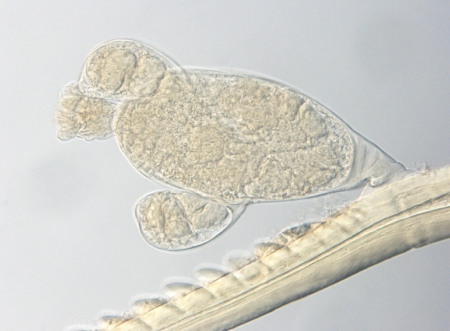
This is one of those weird nature facts that has had me scratching my head for a while. As you may have learned from my post on Taxonomy, a Phylum is one of the largest organizational levels of life on Earth. For example, the phylum Arthropoda includes all insects, arachnids, and crustaceans. Chordata includes anything with a spine: birds, frogs, people, reptiles, fish, and so on. Phyla can have hundreds of thousands of species that live in all kinds of natural environments. And yet this phylum can only be found in one place; truly, a pretty weird one.
Microscopic animals in the genus Symbion are mysterious symbionts that live in the gills and mouthparts of marine lobsters. These tiny critters feed on extra food that the lobsters have been eating, and apparently don’t harm their hosts. Symbion individuals have two life stages:
- A “sac-like” asexual stage, where they attach to the lobster’s gill or mouthparts using an adhesive disc
- A smaller sexual stage, in which it becomes either male or female.
These bizarre critters have a dizzying reproductive cycle that involves different individuals growing out of each other, sticking to one another, being converted into organs, and so on. The life history of Symbion deserves is own post altogether, but is truly more strange than anything in science fiction.
12. This mammal’s scientific name means ‘fierce hidden butthole’

You really can’t make this stuff up. One of my favorite mammals, the Fossa of Madagascar (Cryptoprocta ferox) has a super weird scientific name. This strange critter is the largest carnivorous animal on the island, and a major predator of Madagascar’s famous lemurs. The fossa’s Latin name comes from crypto (hidden) and –procta (anus), referring to a pocketlike flap of skin that conceals their anus and genitals. Their specific epithet, ferox, is apparently a fitting one. They have a reputation for being aggressive!
To learn more about scientific names, what they mean, and why species have them, check out this post.
13. Some mangrove trees give live birth

Although certainly odd, this weird nature fact brings out the “aww” factor. Mangroves in the genera Rhizophora (red mangroves), Avicennia (black mangrove), and Laguncularia (white mangrove) have an odd way of reproducing. Instead of producing seeds like most flowering plants, or spores like mosses, they actually produce tiny baby plants! This habit of producing live young instead of eggs, seeds, or other propagules is called vivipary. While nearly all mammals are viviparous (live-bearing), only some reptiles and very few fish (notably, sharks!) are. For plants it’s even more unusual.
At a certain time in their reproductive cycle, these mangroves will actually have little plantlets growing on their outer branches. These will be complete with a little root, stem, and leaves, ready to start their lives somewhere new. When the time is right, the baby mangroves drop off of their “mother” branch and float off in the water. They can be carried great distances, and settle in new, favorable locations where they will germinate.
14. Birds have a butt-gland for natural sunscreen
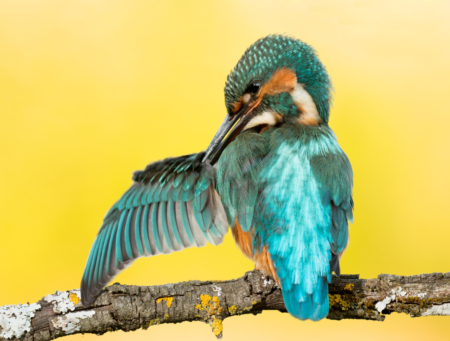
Have you ever watched a bird grooming? Although they regularly molt their feathers to replace old, damaged ones with new ones, birds still need to do some maintenance and upkeep. Specifically, they cover their feathers in secretions from a gland located near the base of the tail. This uropygial gland, also known as a preen gland, secretes chemicals that help protect the birds’ feathers.
While birds are preening, they rub their beak on the gland, then use it to spread the oils over their feathers. The chemicals secreted by the gland, sometimes called preen wax, have antibacterial properties and keep feathers moist.
For waterbirds, they also help keep the feathers waterproof; birds that spend more time in water have bigger preen glands. And yup, these chemicals also protect feathers from ultraviolet light, acting like sunscreen. Some species, like greater flamingos (Phoenocopterus roseus) actually use their preen oil for cosmetic effect. In other words, when they spread it over their feathers, they get more colorful and attractive to potential mates.
15. Whale earwax builds up throughout their entire lives
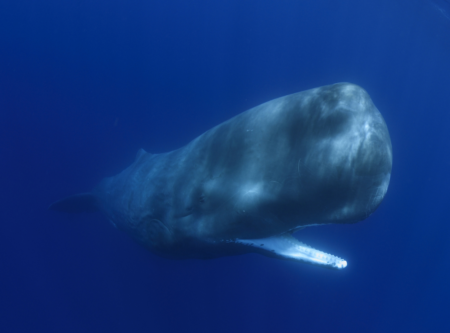
This is definitely one of the more disgusting weird nature facts I’ve come across. Earwax plays an important role in mammal ears, protecting and cleaning their interior parts. Our bodies are constantly producing more of it through special glands which secrete an oil called cerumen, which becomes earwax. For familiar mammals like people, dogs, and cats, extra ear wax comes out of the ear canal and eventually falls away. In the case of whales, however, it works a bit differently.
Living underwater, whales’ external ears are protected from the surrounding water by their earwax. This harder, thicker layer of earwax grows along with the whale. It accumulates over time and completely plugs the ear canal. The result? In large species like the blue whale (Balaenoptera musculus), these earwax plugs can be nearly a foot (30cm) long!
Fascinatingly, these long earwax plugs can give insights into the whale’s health and body condition throughout its lifetime. This is sort of similar to looking at a tree’s rings to differentiate good growing years from bad ones. Some scientists have even used whale earwax to compare their levels of stress hormones between modern times and centuries where they were still hunted.
Thanks for checking out my collection of weird nature facts!
Do you have a weird nature fact of your own that you didn’t see here? I’d love to hear about it! Drop me a line using the Contact Page or leave a comment below. If you enjoyed this post and want to support Gulo in Nature, please share this blog with friends via social media. Thank you!

